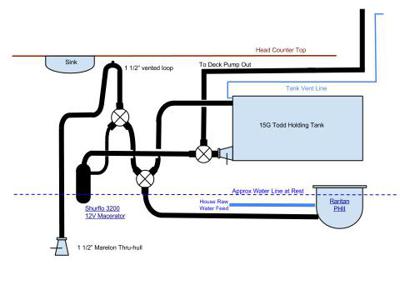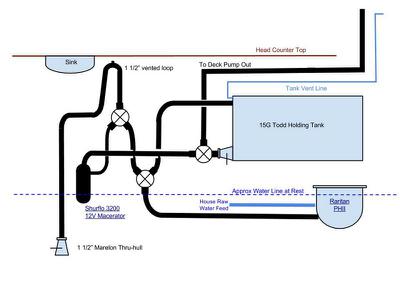You are using an out of date browser. It may not display this or other websites correctly.
You should upgrade or use an alternative browser.
You should upgrade or use an alternative browser.
Revisit/update of holding tank quandry
- Thread starter mel
- Start date
maluhia
Jim Ball
Here is an inexpensive system used in the rv industry Dave.
http://www.rvprobes.com/howitworks.html
or marine,
http://www.wemausa.com/sensors/level-HoldingTank.shtml#.U9wvY6PCeKI
http://www.rvprobes.com/howitworks.html
or marine,
http://www.wemausa.com/sensors/level-HoldingTank.shtml#.U9wvY6PCeKI
datswite
Ken Ferrari
Ken Kurlychek installed this one in his 384:
http://www.sailorssolutions.com/index.asp?page=ProductDetails&Item=TM01
I saw this at the Spring boat show in Annapolis this year:
http://www.electrosense.com/
http://www.sailorssolutions.com/index.asp?page=ProductDetails&Item=TM01
I saw this at the Spring boat show in Annapolis this year:
http://www.electrosense.com/
svpilgrim
Jeff Lovett
We are installing a 15G, plastic Todd tank under the counter in the head.
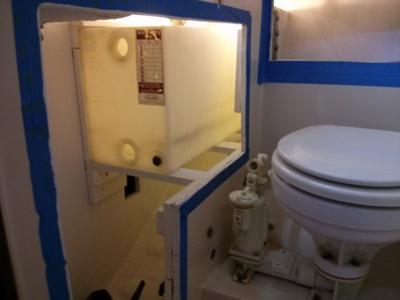
tank
Pro:
'''All black water associated plumbing is confined to the head.
'''The length of 1 ''''' sanitation hose required for the head plumbing is dramatically reduced
'''The holding tank is located above the waterline
'''The black water system requires one less thru-hull below the waterline.
'''All the discharge thru hull fittings (black water and sink drains) are now located on to port and all intake fittings are on starboard. Thus decreasing the likelihood of pulling our own waste water back onboard.
'''Easy to visually check the level in the holding tank.
Con:
'''Reduction in holding tank capacity. On our M34 we lived with the same 15G holding tank and rarely had an issue with capacity.
'''Must relocate the waste pump out fitting on deck.
'''Holding tank vent line now longer or must relocate vent to head area.
Just posted a description of the project and additional images on our website...
http://m382pilgrim.blogspot.com/
Will continue to post updates as the plumbing progresses.

tank
Pro:
'''All black water associated plumbing is confined to the head.
'''The length of 1 ''''' sanitation hose required for the head plumbing is dramatically reduced
'''The holding tank is located above the waterline
'''The black water system requires one less thru-hull below the waterline.
'''All the discharge thru hull fittings (black water and sink drains) are now located on to port and all intake fittings are on starboard. Thus decreasing the likelihood of pulling our own waste water back onboard.
'''Easy to visually check the level in the holding tank.
Con:
'''Reduction in holding tank capacity. On our M34 we lived with the same 15G holding tank and rarely had an issue with capacity.
'''Must relocate the waste pump out fitting on deck.
'''Holding tank vent line now longer or must relocate vent to head area.
Just posted a description of the project and additional images on our website...
http://m382pilgrim.blogspot.com/
Will continue to post updates as the plumbing progresses.
I also installed the same sensor that Ken did...but I had to install the internal model not external version since no way to get to outside of tank. Bit tricky with initial setup since you have to determine when tank is E, 1/4,1/2, and full and enter info into the control display unit.
In the old files, discussion about how my boat's holding atnk was never plumbed and what I went through to get it done. That's why I had to find an internal sensor that would not be affected by the "stuff".
Melinda
In the old files, discussion about how my boat's holding atnk was never plumbed and what I went through to get it done. That's why I had to find an internal sensor that would not be affected by the "stuff".
Melinda
Hi Jeff:
Interesting layout.
I have some concern about the complexity and number of connections that 3 three-way valves create.
While I'm not a fan of Beneteau, we charted a boat with a somewhat simplified but similar layout. The head pumped directly into the holding tank that was mounted above the waterline behind the head. There was a large-diameter discharge line to a seacock and a deck pump-out fitting and vent. The overboard discharge was by gravity only (no macerator). Sure the macerator has benefit but simple is good.
You could tee the deck pump out and overboard drain from the bottom of the tank without a 3-way valve to minimize connections.
Interesting layout.
I have some concern about the complexity and number of connections that 3 three-way valves create.
While I'm not a fan of Beneteau, we charted a boat with a somewhat simplified but similar layout. The head pumped directly into the holding tank that was mounted above the waterline behind the head. There was a large-diameter discharge line to a seacock and a deck pump-out fitting and vent. The overboard discharge was by gravity only (no macerator). Sure the macerator has benefit but simple is good.
You could tee the deck pump out and overboard drain from the bottom of the tank without a 3-way valve to minimize connections.
svpilgrim
Jeff Lovett
Jim -
The pump up distance to the inlet of the holding tank is lower in elevation than the original vented loop for overboard discharge. If the toilet pump would overcome the head pressure in the original system then it will not have an issue pumping waste into the holding tank.
Having not used the head previously I tested it last week by placing a bucket of water on the floor and flushing the head into another bucket on the head counter top. I did not want to complete the head plumbing only to discover the toilet was not working. The toilet had no trouble pumping water to counter top level.
Jeff
The pump up distance to the inlet of the holding tank is lower in elevation than the original vented loop for overboard discharge. If the toilet pump would overcome the head pressure in the original system then it will not have an issue pumping waste into the holding tank.
Having not used the head previously I tested it last week by placing a bucket of water on the floor and flushing the head into another bucket on the head counter top. I did not want to complete the head plumbing only to discover the toilet was not working. The toilet had no trouble pumping water to counter top level.
Jeff
svpilgrim
Jeff Lovett
Alan -
Thanks for sharing your thoughts. I do support the K.I.S.S. theory and I did consider simply allowing the tank to gravity discharge. The angle down to the thru-hull is awkward unless I place a 90 degree elbow at the tank exit. I was fearful this elbow would plug easily.
The macerator inlet is below the level of the tank and the macerator is rated for a 4 foot lift so I feel it will assist with clearing the tank completely.
The Lavac Head system we had on C'est la Vie (our M34) was plumbed by the previous owner so the same manual pump was used to flush the toilet, discharge the holding tank, and empty the shower pan. The system above is very simple by comparison.
Jeff
Thanks for sharing your thoughts. I do support the K.I.S.S. theory and I did consider simply allowing the tank to gravity discharge. The angle down to the thru-hull is awkward unless I place a 90 degree elbow at the tank exit. I was fearful this elbow would plug easily.
The macerator inlet is below the level of the tank and the macerator is rated for a 4 foot lift so I feel it will assist with clearing the tank completely.
The Lavac Head system we had on C'est la Vie (our M34) was plumbed by the previous owner so the same manual pump was used to flush the toilet, discharge the holding tank, and empty the shower pan. The system above is very simple by comparison.
Jeff
maluhia
Jim Ball
Jeff, is there a big reason to change the location of the holding tank from the original keel location to where you installed it? As I said, the keel seems better suited for the black water as Morgan placed it. I guess the question is why change something that does not seem to broken? What is the benefit?
svpilgrim
Jeff Lovett
I've received feedback from multiple sources that the "Y" valve downstream of the holding tank is overkill and a simple "T" junction will suffice.
Here is an updated drawing that notes the change to a "T"
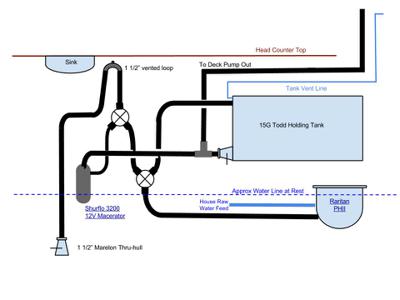
head plumbing 8.3.14
With this set up a pump out will pull a vacuum on the macerator. Is it ok to pull a vacuum against the macerator?
Here is an updated drawing that notes the change to a "T"

head plumbing 8.3.14
With this set up a pump out will pull a vacuum on the macerator. Is it ok to pull a vacuum against the macerator?
svpilgrim
Jeff Lovett
After experimenting with the various hose runs and fittings here is the reality of Pilgrim's head plumbing...
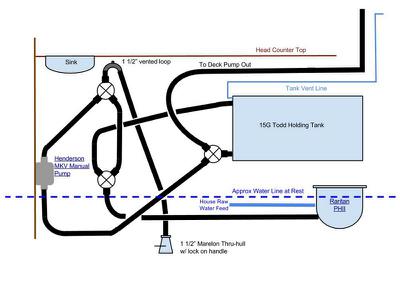
head plumbing
The concept is identical to my plumbing schematics, but the reality of routing the hoses and complying with physics necessitate some deviations.
I have made two hardware changes to the plan.
Comments both here and on our website... http://m382pilgrim.blogspot.com/, have inspired me to revisit the use of a Whale MKV manual pump vs. the Surflo electric macerator. Based on the K.I.S.S. theory and personal experience I prefer the MKV manual pump. After some experimentation, I realized the pump can be mounted on the center-line wall below the head counter top. The socket for the removable handle is accessible on the wall just forward of the mast. This location provides relatively easy access to all fittings and the clean out port on the pump. I do plan to install the pump level with or slightly above the "Y" valve at the exit of the tank.
Secondly... I've eliminated the 1 1/2" shut off valve at the exit of the tank. I feel the "Y" valve downstream of the holding tank will provide enough control to facilitate repairs while mitigating messes.
Hope to share some images of the install soon.

head plumbing
The concept is identical to my plumbing schematics, but the reality of routing the hoses and complying with physics necessitate some deviations.
I have made two hardware changes to the plan.
Comments both here and on our website... http://m382pilgrim.blogspot.com/, have inspired me to revisit the use of a Whale MKV manual pump vs. the Surflo electric macerator. Based on the K.I.S.S. theory and personal experience I prefer the MKV manual pump. After some experimentation, I realized the pump can be mounted on the center-line wall below the head counter top. The socket for the removable handle is accessible on the wall just forward of the mast. This location provides relatively easy access to all fittings and the clean out port on the pump. I do plan to install the pump level with or slightly above the "Y" valve at the exit of the tank.
Secondly... I've eliminated the 1 1/2" shut off valve at the exit of the tank. I feel the "Y" valve downstream of the holding tank will provide enough control to facilitate repairs while mitigating messes.
Hope to share some images of the install soon.
svpilgrim
Jeff Lovett
Dave inquired about the Morgan holding tank level sensor that activated the "Holding 3/4 Full" warning light in the head.
This sensor was located forward of the vent line in bilge. Below is an image of the section of the material separating the bilge from the holding tank that I removed from Pilgrim (1979/ hull#115):
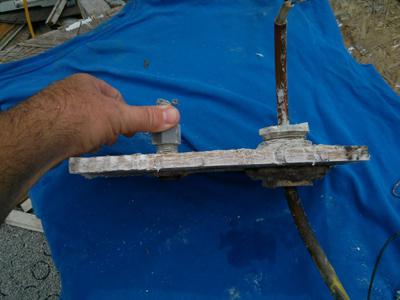
floor
In the image above my thumb is on the old vent line and the sensor wiring is on the right.
In the image below the the bilge side of the section I removed is visible with vent line fitting on right and sensor wiring on left. The portion of the sensor that hung down into the holding tank is visible in the background.
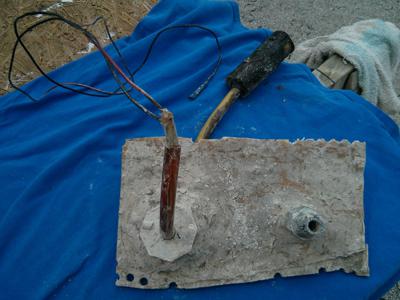
sensor
A duplex wire lead into the somewhat pliable, porous membrane of the sensor. I did not dissect the membrane, but I suspect that each wire terminated in a bare contact. When the fluid in the tank elevates past both contacts the the circuit is completed through the liquid. The completed circuit illuminated the warning light in the head.
This is a very simple system with little to break or wear out. If your warning light in the head is not working, then my best guess it the bulb is bad or the wires between the tank and the light are damaged.
Testing the sensor in the tank could be done by cutting the wires in the bilge and then testing the continuity between the wires that run into the tank. My guess you would find an open circuit when the holding tank is empty and a completed circuit when full. If the sensor passes this test, then the issue is not in the holding tank.
The greatest difficulty with installing a new, modern sensor would be creating an effective seal with the floor of the bilge. Creating a reliable seal with only limited access to the bilge and no access to the inside of the holding tank is the crux of any repairs or modifications to the original holding tank set up.
Hope this is helpful,
Jeff
This sensor was located forward of the vent line in bilge. Below is an image of the section of the material separating the bilge from the holding tank that I removed from Pilgrim (1979/ hull#115):

floor
In the image above my thumb is on the old vent line and the sensor wiring is on the right.
In the image below the the bilge side of the section I removed is visible with vent line fitting on right and sensor wiring on left. The portion of the sensor that hung down into the holding tank is visible in the background.

sensor
A duplex wire lead into the somewhat pliable, porous membrane of the sensor. I did not dissect the membrane, but I suspect that each wire terminated in a bare contact. When the fluid in the tank elevates past both contacts the the circuit is completed through the liquid. The completed circuit illuminated the warning light in the head.
This is a very simple system with little to break or wear out. If your warning light in the head is not working, then my best guess it the bulb is bad or the wires between the tank and the light are damaged.
Testing the sensor in the tank could be done by cutting the wires in the bilge and then testing the continuity between the wires that run into the tank. My guess you would find an open circuit when the holding tank is empty and a completed circuit when full. If the sensor passes this test, then the issue is not in the holding tank.
The greatest difficulty with installing a new, modern sensor would be creating an effective seal with the floor of the bilge. Creating a reliable seal with only limited access to the bilge and no access to the inside of the holding tank is the crux of any repairs or modifications to the original holding tank set up.
Hope this is helpful,
Jeff
datswite
Ken Ferrari
I was working trying to remove my old sensor this weekend. I tried a spanner wrench, but the wrench was too long to get a grip on the sensor. Then a tried vice grips, but they were too small. Next I tried a chain wrench, but I ended up breaking the chain wrench. It's pretty tight.
I know they'll come out. Ken Kurlychek has replaced his sensor. It's a bear, though!
I know they'll come out. Ken Kurlychek has replaced his sensor. It's a bear, though!
svpilgrim
Jeff Lovett
I've long ago throw the cut out piece away so I cannot say first hand. Reviewing my images would lead me to believe that the sensor wires feed thru a threaded PVC end cap. This cap should unscrew???
Be very careful. If you end up spinning the female portion of the fitting that is epoxied into the floor of the bilge, then you've got a much bigger issue.
Be very careful. If you end up spinning the female portion of the fitting that is epoxied into the floor of the bilge, then you've got a much bigger issue.
jnoble
John Noble
It is a 1 1/4 in. female adapter with a plug drilled out for the wires. I made a wrench from 2 in. square tubing, 1/8 in. wall to remove the plug. Slides over the plug like a socket. You can run the wires up thru the tubing something you can't do with a socket unless you cut the wires off. The plug is installed with teflon pipe dope, and the adapter glassed in.
I made a high level switch from SS tubing, a Madison float switch, and swagelock or Parker fittings, process industry stuff. Works great!
I made a high level switch from SS tubing, a Madison float switch, and swagelock or Parker fittings, process industry stuff. Works great!
svpilgrim
Jeff Lovett
Pilgrim's new black water plumbing is completed. After installing per the diagram published above (August 14) I tested the system with fresh water. The flushing the head worked well. I then filled the holding tank via the deck fill. With the tank wast 3/4 full of fresh water, I switched the holding tank discharge valve to offshore pump out via the Henderson Manual Pump. The pump was lower than the level of the tank, great for building a prime, but bad for the long term health of the flapper and joker valves in the manual pump. The manual pump did empty the holding tank, but I fear regular submersion in black water would lead to failure of the internal valves unless I regularly serviced/cleaned the inside of the pump. Weekly or even monthly service on inside of a black water pump is not on my list of desired maintenance. So I returned to the Surflo Macerator Pump.
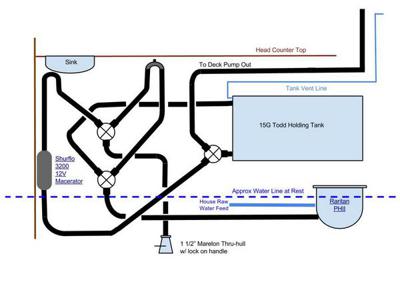
diagram
The system above tested well.
We used an acrylic panel and starboard trim to seal up the hole cut below the head counter top.
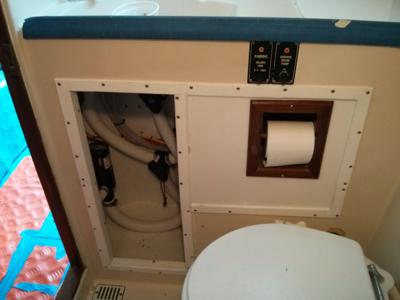
facade
I installed the switch for the macerator in original holding tank full indicator panel just below the fiddle on the head counter top.
The access below the sink in the head is now sized to allow reasonable access to valves and thru-hull fittings below the head counter top. We plan to sew a sunbrella cover that snaps in place for the opening.
The void outboard of the head is now home to the deck wash down pump and provides additional storage.
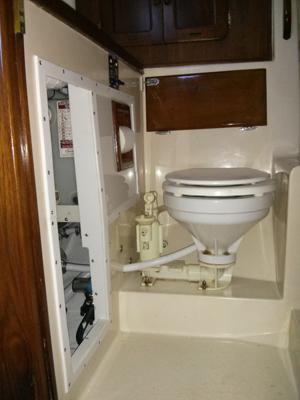
head
The area I cut out is covered by a hinged teak door.
For more images and information on the project check out the photo album: https://plus.google.com/photos/105725086102693499228/albums/6039966836813480481
To follow along with our refit check out our website: http://m382pilgrim.blogspot.com/

diagram
The system above tested well.
We used an acrylic panel and starboard trim to seal up the hole cut below the head counter top.

facade
I installed the switch for the macerator in original holding tank full indicator panel just below the fiddle on the head counter top.
The access below the sink in the head is now sized to allow reasonable access to valves and thru-hull fittings below the head counter top. We plan to sew a sunbrella cover that snaps in place for the opening.
The void outboard of the head is now home to the deck wash down pump and provides additional storage.

head
The area I cut out is covered by a hinged teak door.
For more images and information on the project check out the photo album: https://plus.google.com/photos/105725086102693499228/albums/6039966836813480481
To follow along with our refit check out our website: http://m382pilgrim.blogspot.com/
svpilgrim
Jeff Lovett
Thomas, Where did you place the electrical connection and fiberglass box that contains the pump?
If we keep the anchor locker on the foredeck, then we will likely mount the hose fitting in the locker. If we eliminate the locker, then we will go for a flush mount deck fitting closer to the pump.
Jeff
If we keep the anchor locker on the foredeck, then we will likely mount the hose fitting in the locker. If we eliminate the locker, then we will go for a flush mount deck fitting closer to the pump.
Jeff
stnick
lee nicholas
Jeff , I let my anchor was down right where it was in the corner of the anchor locker.
I cut up a 2 inch PVC the long way and cut like 1/3 of it away so the pipe would act as a shield. Than i glassed it in . Because that is the all chain side of my anchor locker. I just just ran it thru the table saw.The deck wash in on the Starboard side and the pump is in the locker of the Vee birth with thru hull and all. Pressure pump so open hose turns on the pump. Power back to the panel with its own ckt breaker switch.
I cut up a 2 inch PVC the long way and cut like 1/3 of it away so the pipe would act as a shield. Than i glassed it in . Because that is the all chain side of my anchor locker. I just just ran it thru the table saw.The deck wash in on the Starboard side and the pump is in the locker of the Vee birth with thru hull and all. Pressure pump so open hose turns on the pump. Power back to the panel with its own ckt breaker switch.
tfrere
Thomas McNulty
Jeff,
I placed the electrical connection on the inboard side of the starboard toe rail over the v-berth. I used the door over the v-berth drawers to access the area. I ran a new cable from the electric panel with an independent breaker for the pump. The pump is mounted in a fiberglass box which is portable. I can also plug it in near the cockpit. Works great.
I placed the electrical connection on the inboard side of the starboard toe rail over the v-berth. I used the door over the v-berth drawers to access the area. I ran a new cable from the electric panel with an independent breaker for the pump. The pump is mounted in a fiberglass box which is portable. I can also plug it in near the cockpit. Works great.
Share:


